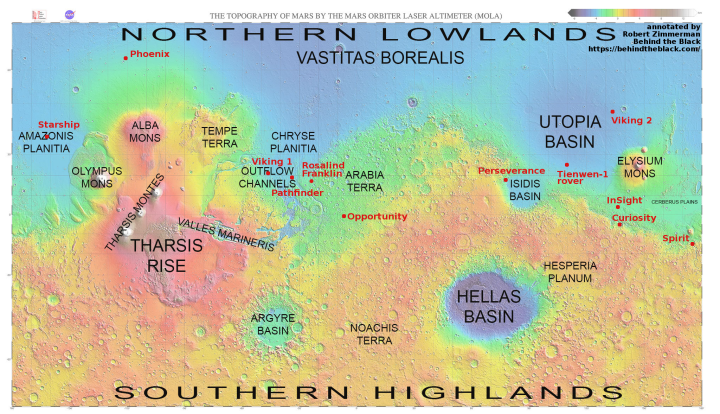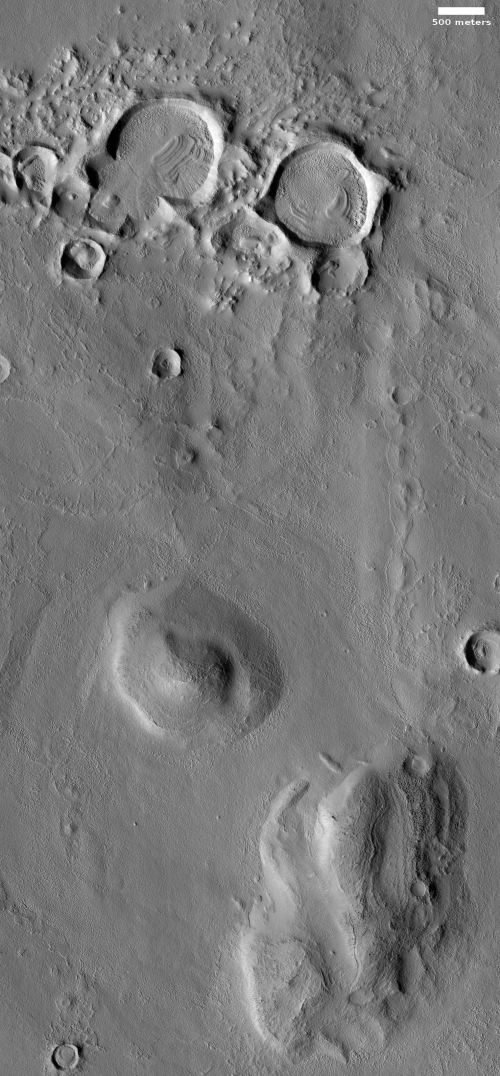Utopia Planitia, the prime landing site for China’s Tianwen-1 Mars rover
Today’s cool image is not only cool, it gives a nice feel for the likely shallow ice table that is probably found close to the surface throughout the lowland northern plains of Utopia Planitia, which is also the prime landing site for China’s Taenwen-1 Mars lander/rover, scheduled for launch sometime in the next four days. [Update: there are now indications the launch will not occur until early August.]
The photo to the right, rotated, cropped, and reduced to post here, was taken on May 9, 2020 and shows a nice collection of strange land forms on the western edge of Utopia Planitia. In this one picture we can see large mounds that might be evidence of cryovolcanic activity (mud volcanoes), strings of small mounds that might be the same but that also suggest underground faults and voids, and distorted and eroded craters that could have buried glacial material in the interiors.
The largest crater in the upper left looks like it is actually filled with ice that has also spilled over to fill the adjacent and linked depression.
This location is quite typical of Utopia Planitia. See for example this post from May 13, 2020: The blobby wettish flows of Mars. In the mid-latitudes here we find ample evidence that buried very close to the surface is an ice table that when hit by an impact melts to form these strangely shaped craters.
China’s actual target landing area is far to the east of today’s cool image, in an area that is appears far less rough. According to this Nature Astronomy paper [pdf], published on July 13th, Tianwen-1 will enter orbit around Mars in February, spend two or three months scouting the terrain below before sending the lander and rover to the ground. They need this time to scout because China cannot request high resolution images from Mars Reconnaissance Orbiter (MRO) to get a better understanding of the terrain at their landing site. U.S. law forbids this communist and hostile power access to our high technology. They need to do it themselves, using their own orbiter. This is one reason why Tianwen-1 is a combined orbiter/lander/rover.
If they find that Utopia Planitia does not serve them, they have indicated [pdf] that Chryse Planitia, a mid-latitude northern lowland plain on the other side of the Mars, is also a candidate landing site.
Either way, the rover carries seven instruments:
The six instruments installed on the rover comprise the Multispectral Camera, Terrain Camera, Mars-Rover Subsurface Exploration Radar, Mars Surface Composition Detector, Mars Magnetic Field Detector, and Mars Meteorology Monitor.
The subsurface radar is potentially its most important instrument, as it will likely be capable of determining if there is an ice table below the surface, and how deep and thick it is. While we have lots of circumstantial evidence as well as orbital data suggesting the existence of the ice table in these mid-latitude lowlands, no lander has arrived in these northern mid-latitudes since the Viking missions in 1976 and Pathfinder in 1997, neither of which had the technology to look for subsurface water ice. Tienwen-1 on the surface with this kind of instrumentation might not only confirm this ice’s existence, it will provide us much better information at higher resolution than obtained from orbit.
Below is a Mercator map of Mars, showing its major features with the locations of all successful landers/rovers, the landing sites for rovers planned for 2020 and 2022, and SpaceX’s candidate landing site for Starship. The map shows that our surface exploration of Mars, which is getting somewhat extensive, also remains limited to the northern lowlands and the transition zone between those lowlands and the southern cratered highlands. At this time we have yet to land in the south, nor does any nation or company have plans to do so. The focus remains in the north, because there we have access to a wide range of geology across many layers, as well as evidence that water ice will be readily accessible.
The northern plains of Mars will be where the first humans will stand and where their first bases will be. It is quite likely that the southern cratered highlands will be considered a low priority target for exploration and settlement for many years.

On Christmas Eve 1968 three Americans became the first humans to visit another world. What they did to celebrate was unexpected and profound, and will be remembered throughout all human history. Genesis: the Story of Apollo 8, Robert Zimmerman's classic history of humanity's first journey to another world, tells that story, and it is now available as both an ebook and an audiobook, both with a foreword by Valerie Anders and a new introduction by Robert Zimmerman.
The print edition can be purchased at Amazon or from any other book seller. If you want an autographed copy the price is $60 for the hardback and $45 for the paperback, plus $8 shipping for each. Go here for purchasing details. The ebook is available everywhere for $5.99 (before discount) at amazon, or direct from my ebook publisher, ebookit. If you buy it from ebookit you don't support the big tech companies and the author gets a bigger cut much sooner.
The audiobook is also available at all these vendors, and is also free with a 30-day trial membership to Audible.
"Not simply about one mission, [Genesis] is also the history of America's quest for the moon... Zimmerman has done a masterful job of tying disparate events together into a solid account of one of America's greatest human triumphs."--San Antonio Express-News



Remember we reach the Mon and made it we beat the Russians to the Moon now its try for Mars